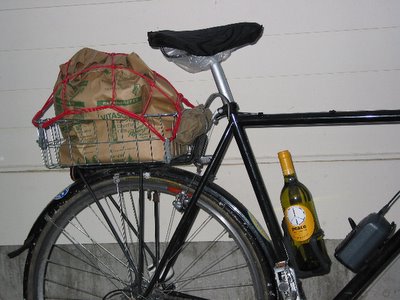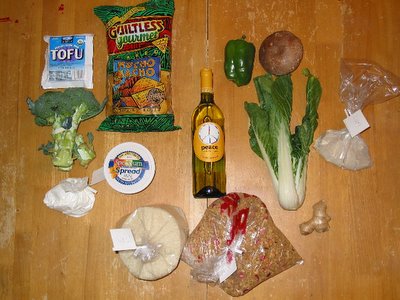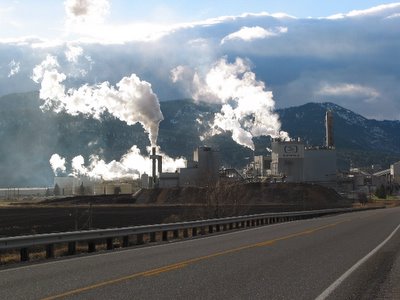A snowy trail ride by fixed gear
Still, a cycler needs a change now and then, and I admit that I was ready for a change from trips to the store in the icy fog. Finally, the fog lifted, snow fell, and just as quickly I was on the fixed gear with food and clothes enough to ride out of the valley.
I pedal downtown to drop off some cider at Rachel's work. Then, I point north into the Rattlesnake for the first time on a fixed gear. The mountain scene ahead is irresistible--endless peaks capped by fresh snow.
The Rattlesnake has been my bike lab for several years now. This was the first place I rode a road bike on trails, and the first place I rode a singlespeed up and down hills--both habits that haven't left me. It's only fitting that I first ride a bicycle that doesn't shift or coast in snow and on trails. I had already decided that if the trails or snow were too sketchy, or if my cold bothered me, I'd just ride the road up to the top and head back. Not that I expected trouble. I'm mostly past worrying about whether things are doable on a bike. Now I mostly wonder how much fun it's going to be.
Those are the thoughts running through my head until they're displaced by the first looming hill ahead. Oddly enough, this is the hill that decided my one gear. I followed the advice of the ancients and figured out the highest gear that I could climb my toughest hill with. Well, and then I added a little because someone told me that I would be able to climb better with a fixed gear. I hadn't really given it another thought until now. Hmmm...
At the base of the hill is a turnoff that rolls through Greenough Park and winds up more gradually. I found myself steering for the turnoff. I caught myself in time and pointed back up the hill. It's always better to know, right? The first half went well enough, but then two-way traffic obliged me over to the shoulder. The gravel, slush, and broken pavement killed my spin and had me laboring up the last half. I made it, though, panting, but I know that confidence is more important than leg strength for most cyclers, and this hill would be easier next time.
First trial over, I was free to spin along and begin the gradual climb up toward the mountains. It's hard to believe I can tell the difference from 10 miles away, but the first snow of the year always lays prettiest on the mountains here. I'd vouch for it to anyone.
A piece further and I come to the community farm, my turn, and the day's second trial. A little further is a steep dirt hill that cuts over to the pedestrian bridge over Rattlesnake Creek. I usually walk this hill when things are frozen, but I feel very confident sensing traction on the fixed gear. I ease to the top and commit. Down I go, standing and controlling my speed by resisting the pedals. I doubt it looks like this to a passerby, but I feel in complete control, gliding down the hill with an uncanny feeling of connection with the bike. Less eloquently, it feels like I'm walking down the hill.
Either way, I arrive safely at the bottom, roll onto the bridge and prop an arm against the wooden railing to ponder the creek. It's still running clear and free. In another month, this will be an icy chute with the creek flowing silently beneath. I watch a chipmunk nervously making his rounds and probably imagining the same scene.
Crossing the bridge, I merge into sparse traffic heading up the main road. Still climbing steadily, I duck into a neighborhood where the spur trail, and my third trial, await. The snow here is getting steadier, and my rear tire tells me that there's a nice layer of ice underneath. Nervously, I round the corner and ease downhill toward the trailhead.
I've found that there are lot of things to think about before riding a fixed gear somewhere new but very few things to think about once I'm riding it there. I pedal and steer but mostly pedal. I imagined I'd be fretting about whether each rock was going to strike my pedal, about whether I'd make it up this steep hill or down that one. Nope, just pedal. Pretty soon, I found it was a lot like riding a singlespeed here the first time. And a lot like riding a road bike here the first time. The bike makes it kind of neat, but pretty soon I'm staring at the woods, the tracks in the snow, the creek, and I've mostly forgotten that I'm doing something new.
I will say I was pleasantly surprised by the traction I had slogging up hills and the braking control I had going down them. Mainly, the bike didn't make the ride any less fun, and probably even added a bit.
I soon reached the short piece of somewhat more challenging trail. This took a little more concentration. About this time, an older couple came walking up the trail. I slowed and moved aside for them.
"Kind of slick for biking, isn't it?" The older man asked.
"A little slick, but mostly fun." I blurted out without thinking.
I heard the man tell his wife as I rode off, as if remembering his own youth, "It's the challenge of it, that's what keeps you going."
I would tuck this wisdom away to ponder later. Right now, there were some rocks to deal with. As my confidence grows, I pick up speed and start flying through the woods. Too soon, I pop out onto the road again and pause to eat and let my fingers warm up before the descent. I was pleased but not surprised that I could ride the trail on a fixed gear in the snow.
As I spun home down the long, 5 mile hill that leads to town, I pondered what the old man had said on the trail. What is it about humans that makes us love a challenge? So much of what we do for fun is for the challenge, and I don't think it's just a modern invention. Sports, hobbies, even travel. Who's ever heard of "Europe on $500 a day!"? I realized that part of the joy in cycling is the constant challenge. Sheldon Brown probably puts it best in talking about the unlikely idea of touring on a singlespeed:
"[S]inglespeed touring is not as goofy an idea as it might sound at first blush--if you're not in a hurry and value simplicity and reliability, a singlespeed is eminently tourable. Yes, you might have to get off and walk up a few hills, but that's hardly a tragedy, in fact sometimes it can be a nice change of pace! If you are in a hurry, why are you on a bicycle?" -Sheldon Brown
He's right, of course. There are easier ways to do almost anything we do on bicycles, including getting up to the top of the Rattlesnake on a snowy afternoon. But afterwards, sitting at the keyboard with a cup of hot cider, I sure wouldn't have much to write about.
Labels: ride stories




